Clifford Garstang's Blog, page 111
January 17, 2012
The New Yorker: "Labyrinth" by Roberto Bolaño
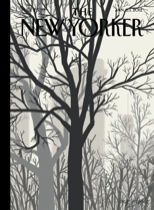
January 23, 2012: "Labyrinth"by Roberto Bolaño
The Q&Awith Barbara Eppler, Bolaño's first American Publisher, is interesting, butof no help with this story, which I think I love. I say I think I love it because I don't know that I have the energy tounpack it to see what's there. If there's nothing underneath the dazzlinglanguage and the manipulation of time, then I might like it less.
The story is based on a picture, and that picture appears tobe the one in the magazine illustrating the story—take a look at it as you readthe description of the people he names. I've reproduced it here, although whenI read the story on my Kindle I hadn't yet seen it. He's describing this tableand these people in great detail, whose actual names he uses, and then, Isuppose—although I have no way of knowing—he is fabricating the rest: what theydo with each other outside of the picture, what is happening beyond thepicture's frame, etc.
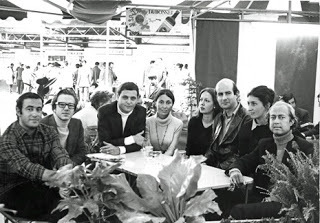 What appeals to me here isn't so much what happens, but theintersection of the real and the imagined, which includes a person who isn't inthe picture at all, and also the way in which the characters, as time passes,have lives outside of the picture but are also always frozen in the photograph.
What appeals to me here isn't so much what happens, but theintersection of the real and the imagined, which includes a person who isn't inthe picture at all, and also the way in which the characters, as time passes,have lives outside of the picture but are also always frozen in the photograph.After the detailed description of the people in thephotograph, about a third of the way into the story the author begins toimagine: "Let's imagine J.-J. Goux, for example . . ." He has Goux leave thepicture and walk down the street. Then he imagines that some of the people arelooking at someone out of the frame, and imagines this might be "a youngjournalist from South America, no, from Central America." He goes on to suggestthat there may be something sinister about this journalist, that he's bitterand will do some harm. It's wonderfully imaginative, even if in the end itdoesn't produce any real action.
What do other people think? Or do you know something aboutthe people the author has named here?
Published on January 17, 2012 07:52
January 16, 2012
Guest Editor for Smokelong Quarterly
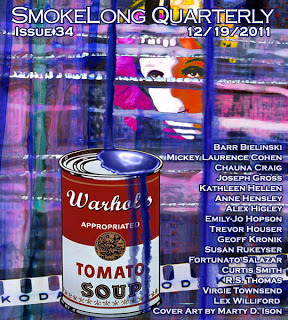 Starting today, for one week only, I am the Guest Editor at Smokelong Quarterly, one of the very best magazines around that focuses on flash fiction. It's also a beautiful magazine, with great/bold cover art. I was honored to be invited.
Starting today, for one week only, I am the Guest Editor at Smokelong Quarterly, one of the very best magazines around that focuses on flash fiction. It's also a beautiful magazine, with great/bold cover art. I was honored to be invited.My job as a Guest Editor is to read this week's submissions. They've already started to come in . . .
Thanks for the invitation, Smokelong staff. And to the contributors, I look forward to reading your work!
Published on January 16, 2012 12:12
January 14, 2012
Year of the LitMag: One Story #156
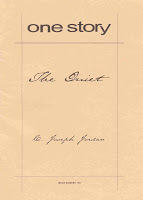
[Note: this is the 4th installment in my Year of the LitMag series. If you would like to contribute to the series, leave a comment below or shoot me an email.]
OneStory #156 "The Quiet" by C. Joseph Jordan
By now, everyone knows about One Story, right? It's a little magazine that comes out every fewweeks and contains just one story. It's a cool concept and it's also availableon Kindle. (As soon as my print subscription expires, I'll switch to the Kindleversion, I think.) Lunch Hour Storiestried the same thing a few years ago, but it didn't last as long, and is nowgone.
This story by C. Joseph Jordan is a nice read about aVietnam vet who comes home to Oregon after two tours. It's been a tumultuous fewyears for him—his father died while he was in Vietnam; he fell in love while onR&R in Sydney, Australia; he killed a Vietnamese kid with a knife. And nowhe's finally home. But as we know from every war story we've ever heard orread, it's not that easy, and Sergeant Adlai Malick has some demons and secretshe has to deal with. So, upon arrival at his mother's house, where there is abig, noisy welcome home party waiting for him, he goes into the basement insearch of quiet. (Be sure to check out the editor'sinterview with the author.)
Although the story is thoroughly readable, and my sympathiesare with Sergeant Malick throughout, even when I fear he's going to explode,even when he behaves badly, it had a feeling of familiarity to it. Becausehaven't we read this story before? Beginning with "A Soldier's Home" by ErnestHemingway and followed by countless others, we've seen the difficulty a soldierhas in coming home from war. Malick is damaged by the war and he is going tohave to find a way to cope, or not, but I don't feel that the story takes usanywhere new. Am I asking too much? Isn't it enough that I haven't seen thisparticular veteran and his particular circumstances before? Maybe. Maybe we'reready for a new take on this subject. I just wish it had been a little moresurprising.
Published on January 14, 2012 07:45
January 13, 2012
Tips for Writers: Don't Give Up!
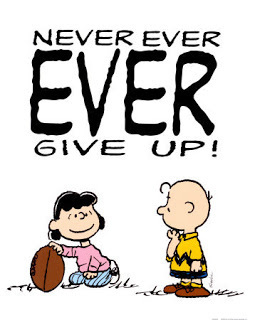
Last week I wrote that it is important to read—books and literarymagazines. We not only learn from reading good work in our chosen genre, but wealso learn which publishers are buying the kind of work we're writing.
While that's true, excellent work is likely to be welcomeanywhere, except for the very specialized genre markets. And you'll see allkinds of stories in the top magazines. At most, they vary in edginess, but that'sabout it. (Read an issue of Ploughshares and then read an issue of TinHouse and you'll get a sense of what I mean.)
But there's something that a writer won't be able to learnjust from reading a magazine, and that's taste. A story that one editor rejectsmay be loved by the next editor who sees it. It might even have been loved ifthe first editor had seen it a day earlier and was in a better mood.
For example, I just had a story appear in Blackbird. (See "TheReplacement Wife.") This is a terrific magazine—one of the best, if not the best online magazines—andI've been sending them work for years. And I've been sending this story aroundfor a couple of years, too, collecting some rejections. Not as many rejectionsas I've had for some other stories, but some other good magazines had a chanceto take this story and they didn't. I have no idea why, other than to say thatit's a matter of the editors' taste.
I've got another story coming out in the next issue of Bellevue Literary Review, "A Hole in theWall." This story is a favorite of mine and was the second one I wrote in thenovel in stories that's coming out this September from Press 53, What the Zhang Boys Know. It has collected quite a few rejections,and some of those rejections came from some pretty obscure magazines. Forwhatever reason, though, something about the story appealed to the BLR editors,and something about it did NOT appeal to the editors of those other magazines.
You can spend all the time you want analyzing magazines (andI do, asking myself whether they have a particular slant), but in the end doesn'tit all boil down to taste? Editors publish what they like, and we're not allgoing to like the same things. The lesson here is: Don't give up. If it seemslike a story has been rejected too many times, it may just be that it hasn'tyet found the right editor.
Published on January 13, 2012 05:33
January 12, 2012
Pushcart Prize Ranking (Poetry) for 2012

[Note: If you find the Pushcart Prize Rankings helpful,please consider making a donation to support this blog. Alternatively, considerbuying my book. Donation and Purchase buttons are in the sidebar to the right.]
By now, my ranking of literary magazines is well known among writers. I began the ranking several years ago as I attempted to prioritize my submissions ofshort stories. I analyzed ten years of Pushcart Prize anthologies and rankedthe magazines based on how many prizes and special mentions they had earned usinga simple formula to come up with a score. That was the only factor in myranking, attempting to keep it as objective as possible. I updated the rankingeach year when the new anthology was released, adding the new data whiledropping the data that was more than ten years old.
At the end of 2011, when I updated the Fiction rankings, Idid the analysis for Nonfiction as well, and came up with a separate ranking.Both of these lists, as well as the Fiction rankings from prior years, arelinked in the sidebar at right.
And now, finally, I've applied the analysis to Poetry.
Some people don't like rankings, and I can sympathize withtheir view. But I maintain that the Pushcart Prize is a reasonable proxy forquality, and I think many writers hope to place their work in the best possiblemagazine. If I were a poet, I'd want to see my work in Poetry, the clear "winner"in this ranking. But I also acknowledge that the Pushcart Press has been slowto recognize the work that is appearing in online magazines, and thesemagazines, some of which are excellent, are under-represented on the list.Writers should keep this in mind.
Are there any surprises here? You tell me. Poetry is clearly dominant, and American Poetry Review is a strong second. But many of the remaining top twenty-five also rank highly in the other genres.
For whatever it's worth to you, here it is:
Pushcart PrizeRanking (Poetry) for 2012 2012 Magazine 2012 Score 1 Poetry 108 2 American Poetry Review 74 3 Kenyon Review 65 4 Ploughshares 59 5 Georgia Review 46 6 Southern Review 45 7 New England Review 42 8 Threepenny Review 41 9 Gettysburg Review 40 10 Virginia Quarterly Review 36 11 TriQuarterly 33 12 Field 32 13 Five Points 30 14 Yale Review 25 15 BOA Editions 21 15 Shenandoah 21 15 Tin House 21 18 Alice James Books 20 19 Agni 19 20 American Scholar 17 20 Barrow Street 17 20 Cincinnati Review 17 23 The Journal 16 24 Literary Imagination 15 24 New Ohio Review 15 24 Notre Dame Review 15 27 Image 14 28 Colorado Review 13 28 Copper Canyon Press 13 28 Crazyhorse 13 28 Iowa Review 13 28 Michigan Quarterly Review 13 33 jubilat 12 33 North American Review 12 33 Rattle 12 33 Runes © 12 37 Blackbird 11 37 Canary 11 37 Chelsea © 11 37 Epoch 11 37 Lake Effect 11 37 Missouri Review 11 37 New American Writing 11 37 New Criterion 11 37 New Letters 11 37 Rivendell © 11 37 Southern Poetry Review 11 37 West Branch 11 49 Alaska Quarterly Review 10 49 Cue Editions 10 49 Eastern Wash. Univ. Press © 10 49 Great River Review 10 49 Green Mountains Review 10 49 Lyric (?) 10 49 New Orleans Review 10 49 Orion 10 49 Spillway 10 49 Turnrow 10 49 Water-Stone Review 10 49 Western Humanities Review 10 61 Massachusetts Review 8 61 Paris Review 8 61 Pleiades 8 64 5 a.m. 7 64 Connecticut Review 7 64 Hotel Amerika 7 64 Ninth Letter 7 64 Paper Street © (?) 7 64 Salamander 7 64 Sarabande Books 7 64 Seneca Review 7 72 Atlanta Review 6 72 Bloom 6 72 Cimarron Review 6 72 Crowd © (?) 6 72 Gulf Coast 6 72 Margie © 6 72 Mid American Review 6 72 New Issues Poetry and Prose 6 72 Perugia Press 6 72 Poems & Plays 6 72 Poetry Review 6 72 Salmagundi 6 72 Smartish Pace 6 72 Sun 6 72 Tupelo Press 6 72 Wave Books 6 88 Anhinga Press 5 88 Arroyo Literary Review 5 88 Bellingham Review 5 88 Blueline 5 88 Chattahoochee Review 5 88 Chautauqua 5 88 Cleveland State Univ. Poetry Ctr. 5 88 Court Green 5 88 Curbstone Press 5 88 Cypher Books 5 88 Denver Quarterly 5 88 Dogwood 5 88 Ecotone 5 88 Eleven Eleven 5 88 Epiphany 5 88 Fence 5 88 Five Fingers Review 5 88 Grand Street © 5 88 Graywolf Press 5 88 Hollyridge Press 5 88 Idaho Review 5 88 Laurel Poetry Collective 5 88 Little Patuxent Review 5 88 Manoa 5 88 Meridian 5 88 MIZNA 5 88 National Poetry Review 5 88 New South Books 5 88 OCHO 5 88 Painted Bride Quarterly 5 88 Parnassus: Poetry in Review 5 88 Partisan Review © 5 88 Pebble Lake Review 5 88 Pleasure Boat Studio 5 88 Poetry Atlanta Press 5 88 Poetry Northwest 5 88 Post Road 5 88 Provincetown Arts 5 88 Quiddity 5 88 River Styx 5 88 Sixth Finch 5 88 Snake Nation Review 5 88 Sugar House Review 5 88 Think Journal 5 88 Third Coast 5 88 Tikkun 5 88 Toadlily Press 5 88 Triplopia (?) 5 88 Utah State University Press 5 88 Vallum: Contemporary Poetry 5 88 Verse Wisconsin 5 88 World Literature Today 5 88 Zone 3 5 88 Verse Press © 5 88 Northeastern Univ. Press 5 88 Chicago Review 5 144 Beloit Poetry Journal 4 144 Raritan 4 144 Southwest Review 4 147 Black Warrior Review 3 147 Boulevard 3 147 Hudson Review 3 147 Prairie Schooner 3 147 University of Pittsburgh Press 3 152 Four Way Books 2 152 Greensboro Review 2 152 Healing Muse 2 152 Nimrod 2 152 PMS 2 152 Quarterly West 2 158 "88" 1 158 Arsenic Lobster 1 158 Autumn House 1 158 Barefoot Muse 1 158 Bat City 1 158 Bellevue Literary Review 1 158 Blue Earth Review 1 158 Bomb 1 158 Boston Review 1 158 Brilliant Corners 1 158 Brooklyn Review 1 158 Callaloo 1 158 Cape Cod Voice (?) 1 158 Columbia Poetry Review 1 158 Crab Creek Review 1 158 Daedalus 1 158 Drunken Boat 1 158 Eleventh Muse 1 158 First Intensity 1 158 Formalist © 1 158 Fort Hemlock Press 1 158 Free Lunch © 1 158 Frostproof Review © 1 158 Hampden-Sydney Poetry Review 1 158 Hanging Loose 1 158 Harpur Palate 1 158 Harvard Review 1 158 Haven Chronicles (?) 1 158 Hayden's Ferry 1 158 Hollins Critic 1 158 Hopkins Review 1 158 Hunger Mountain 1 158 Indiana Review 1 158 InDigest 1 158 Iris 1 158 Kentuckians for the Commonwealth 1 158 Leaping Dog Press 1 158 Live Mag! 1 158 Long Island Quarterly 1 158 Lost Hills Books 1 158 Lynx House Press (?) 1 158 Main Street Rag 1 158 McSweeney's 1 158 MS. 1 158 Natural Bridge 1 158 New Delta Review 1 158 New Haven Review 1 158 November 3rd Club 1 158 Omnidawn Publishing 1 158 Pearl 1 158 Phoebe 1 158 Poetry 180 1 158 Poetry Flash 1 158 Pool 1 158 Rhino 1 158 River City (?) 1 158 Seattle Review 1 158 Sentence 1 158 Sewanee Review 1 158 Speakeasy © 1 158 Specs 1 158 Spoon River Review 1 158 Thunder's Mouth Press © 1 158 TriQuarterly Books 1 158 University of Akron Press 1 158 Upstreet 1 158 Valparaiso Poetry Review 1 158 War, Literature and The Arts 1 158 Willow Springs 1 158 Wordcraft of Oregon 1 158 Xantippe (?) 1 158 ZYZZYVA 1 158 The MacGuffin 1 158 Poetry International 1 158 St. Ann's Review 1 158 Yale University Press 1 158 Southern Humanities Review 1 158 Portland Review 1 158 Sixteen Rivers 1 158 Rattapallax 1 158 Bucknell University Press 1 158 Roundhouse Press (?) 1 158 Michigan State Univ. Press 1
Published on January 12, 2012 18:25
SWAG Writers Update
 Last night was a little overwhelming. We started SWAG Writers (The Staunton-Waynesboro-Augusta Group of Writers, a subgroup of the Blue Ridge Writers Club) about a year and a half ago. Originally I wanted to sponsor readings by visiting writers, and we've been doing that once each quarter or so. Then, borrowing an idea from James River Writers in Richmond, we began a monthly happy hour for writers. That was meant as just a chance to get together to talk about the writing business. And then last year we added an open mic component to our monthly WriterDay gatherings. They've been fun and have attracted quite a few readers. (We meet on the Second Wednesday of each month at The Darjeeling Café in Downtown Staunton, VA.)
Last night was a little overwhelming. We started SWAG Writers (The Staunton-Waynesboro-Augusta Group of Writers, a subgroup of the Blue Ridge Writers Club) about a year and a half ago. Originally I wanted to sponsor readings by visiting writers, and we've been doing that once each quarter or so. Then, borrowing an idea from James River Writers in Richmond, we began a monthly happy hour for writers. That was meant as just a chance to get together to talk about the writing business. And then last year we added an open mic component to our monthly WriterDay gatherings. They've been fun and have attracted quite a few readers. (We meet on the Second Wednesday of each month at The Darjeeling Café in Downtown Staunton, VA.)At our December WriterDay, we got some press coverage. There was an article in the local newspaper and photographs of several of us reading. Partly because of that article, and partly because word is spreading, last nights WriterDay was the best yet. We kept adding tables to our group as more people arrived. Then readers filled some other tables, and we realized that there were quite a few people who had come just to listen. Meanwhile, our signup sheet for the open mic filled up--12 writers signing up for 5 minute slots, including several newcomers.
The readings were wonderful--a mix of fiction and poetry, some serious, some funny. It was a terrific night. Thanks to all who came to read and to those who just listened.
Published on January 12, 2012 05:29
Year of the LitMag: Five Points, Vol. 14 No. 2
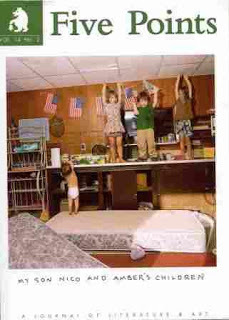
[Note: this is the latest entry in my Year of the LitMag series. If you would like to contribute to the series, leave a comment below or shoot me an email.]
Volume 14 No. 2 of FivePoints just arrived, and it's filled with work by an impressive array ofwriters, including poets Mary Oliver, Billy Collins, Mary Jo Salter, DavidKirby, Dan Albergotti, and others. Plus there's a very interesting interviewwith Kirby by Tom Hunley. I also liked the art portfolio—it seems fewer journalsare doing that these days, and it must be expensive—consisting a series ofphotographs by Chris Verene. They tell quite a story all by themselves.
As usual, I'll concentrate on the fiction. There are four short stories, which for the most part Ienjoyed. They also show a fair amount of variety.
The first story, "The Boat on the Lake," by Lynn Stegner, isquite long, 26 printed pages. It's a traditional story—nothing experimentalabout its form or language—about a husband and wife and their two sons. Thehusband is sick and his brother has come to help the family out, but there's some attraction between the wife and the brother. There's also a neighbor—ahandyman—who plays an important role: "Emory was a broth of a fellow,impossibly shy, his hands always stealing into his pockets, his head slingingsideways whenever it was time to name a fee for his various services, his thickcurly hair long to his shoulder not for any reason other than that he hadn'thad time to get it cut." Great description—"a broth of a fellow." Although I enjoyed the story, it feels rather long for what it achieves.
Mark Winegardner's "Agent Halvorsen Addresses the SpaceCoast Optimists" suggests that the editors don't mind a little formalexperimentation. The story takes the form of a speech, which itself is said to bean artifact left to a college library found among the speakers effects. In the speech, Agent Halvorsen gives thestory of his career, which had its ups and downs, to say the least. It's an innovative piece.
"Giveaway" by Lauren Watel seems, at first, like a familiarpost-partum depression story. But Joan, the point of view character, is apsychologist, and so her struggle after giving birth is perhaps a little moreself-examined than it might be otherwise, and since she's married to apsychiatrist, she gets it from him, too. Not to mention the well-meaning andhelpful older sister.
Finally, the editors seem to like a bit of humor, in amelancholy sort of way, judging by "Light & Luminous" by Tania James, abouta Chicago Indian dance instructor whose relevance to her students is fadingeven as a rival teacher is gaining fame. I like the fresh setting here.
Alas, I submit to Five Points and get nowhere. Goodmagazine, tied for 16th in the PerpetualFolly Pushcart Prize Ranking (Fiction).
[I liked the issue very much, but is it petty of me to pointout that the verb "to lay" is misused at least twice, including two times onone page? Writers should get this right; editors should catch it when they don't.I understand when this is done in dialogue, or in the voice of somecharacters, but in this case I don't see any justification for it. This is thekind of error that drives me a little nuts. I suspect most people don't care, but I wish everyone did.]
Published on January 12, 2012 04:43
January 11, 2012
Writing the Short Story on Writers.com--Sign Up Now!
 A new section of my online creative writing class begins on Monday, January 16, so there are only a couple of days left to sign up. This has been a popular class in the past and is always a lot of fun. It lasts 10 weeks and includes a lecture component with discussion, readings, and writing exercises, PLUS a full-blown workshop in which your story will be critiqued by all members of the class.
A new section of my online creative writing class begins on Monday, January 16, so there are only a couple of days left to sign up. This has been a popular class in the past and is always a lot of fun. It lasts 10 weeks and includes a lecture component with discussion, readings, and writing exercises, PLUS a full-blown workshop in which your story will be critiqued by all members of the class.To see the course outline and to register, go to: Writing the Short Story: Make Your Story Great!
Published on January 11, 2012 13:10
Forthcoming Books: The Mindful Writer by Dinty Moore
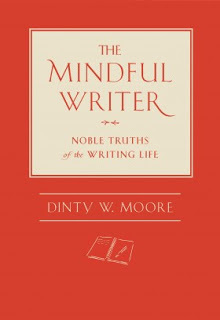 [Note: I'm beginning this new feature, Forthcoming Books, to draw attention to titles I'm looking forward to that haven't yet been released. If you've got a book coming out in the near future, leave a comment or send me an email and I'll look into it.]
[Note: I'm beginning this new feature, Forthcoming Books, to draw attention to titles I'm looking forward to that haven't yet been released. If you've got a book coming out in the near future, leave a comment or send me an email and I'll look into it.]The Mindful Writer by Dinty Moore is scheduled for release in May 2012. I'm looking forward to it because Dinty Moore is the editor of the excellent publication, Brevity, but also because I just read his book The Accidental Buddhist, about his exploration of the various branches of Buddhism in America. And this new book about the creative process with, apparently, a Buddhist slant, looks like it's right up my alley.
Here's a recent Interview with Dinty Moore.
Published on January 11, 2012 06:12
January 9, 2012
The New Yorker: "A Brief Encounter with the Enemy" by Said Sayrafiezadeh
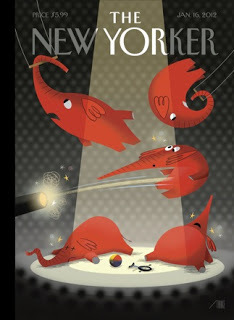
January 16, 2012: "ABrief Encounter with the Enemy" by Said Sayrafiezadeh
I found this story depressing as hell. It is apparently partof a collection coming out this year from this author, and I'll guess that thelast couple of stories he's had in the New Yorker will be in the book. Noteparticularly the story "Paranoia"which ran last year and also mentions this distant war on the peninsula againstan unnamed enemy.
In this story, Luke, who is apparently in a National Guardunit, is called up to serve in this war. It's supposed to be over soon, exceptthat it isn't. Luke, 27, with an Associate's Degree, doesn't mind leaving hismeaningless job for this adventure, which is how he and the girl he thinks he'sinterested in, Becky, view it. But his role in the war is also boring. He'sbuilding a bridge to nowhere, or maybe it's to a spot where there are said tobe 880 of the enemy. In any case, he spends his time watching movies, eating,and it's not very stressful except for the sergeant who occasionally gives themgrief. Until, one day just before their year is up and they are about to gohome, Luke encounters the enemy.
And that's all I'm going to say, as the encounter is the story, and makes the story, for me.
I read the piece as an indictment of war. A very effectiveindictment, it seems to me.
Published on January 09, 2012 15:55



